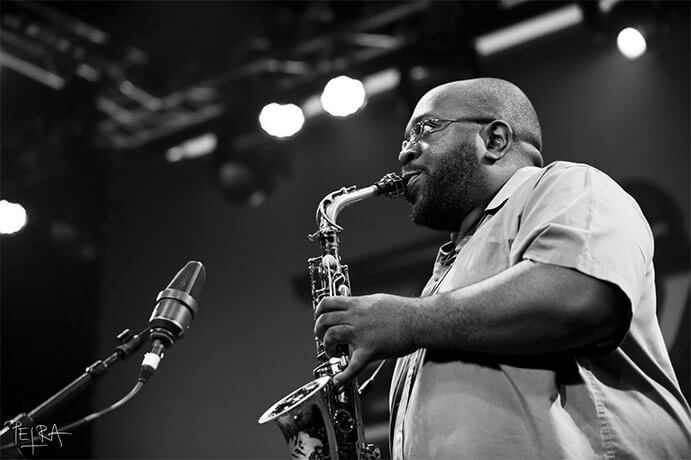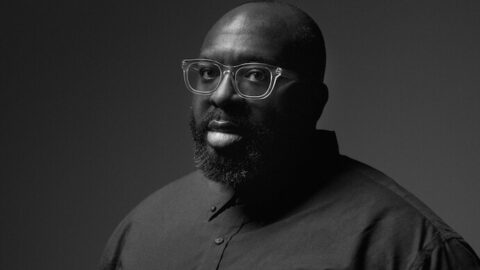Audiences were treated to a thought-provoking performance on Nov. 21 as part of the Kaufman Music Center’s “Artist as Curator” series. Featuring two works by saxophonist and composer Darius Jones, the evening’s music examined two significant and distinct sonic and philosophical spaces.
Written for two female-identifying voices, two male-identifying voices, and vibraphone, Samesoul Maker is an hour-long, slowly unwinding journey in 15 parts accompanied by the stardust twinkle of small hand bells held by the vocalists. The work occupies a segment of Jones’ oeuvre that traverses and builds Afrofuturistic Sci-Fi worlds and depicts an alien birth ritual, exploring “the commitment of the father figure during the process of childbirth on the planet Or’gen.” With its vast, open harmonies, often in the nude of accapella voices, the work immediately took on an air of the sacred.
The father figure was sung with particularly beautiful resonance by Sunder Ganglani; embodying the titular Samesoul Maker, each cyclical repetition depicted his prayer of wishes and love for the new child. Repeated intonations of alien words, muted and unmuted ringing and scraping of the hand bells, and slowly shifting sonorities have presence in much of the work.

Soaring solos by Gelsey Bell were goosebump-inducing and true a joy to watch; impassioned performances by Aviva Jaye and Paul Pinto completed the vocal quartet, and Levy Lorenzo’s steady, reverent performance on the vibraphone created a hallowed space for this alien tale.
The four-movement fLuXkit Vancouver had an air of a jam session we weren’t invited to, but were peeking in on anyway. Written for alto saxophone, drums, two violins, cello, and bass, each musician frequently seemed within a world entirely of their own; communication between the musicians was surprisingly subtle throughout. With an often-amorpheous beat, the manufactured chaos of sound had some fun moments thrown in alongside the confronting. The work opened in tremolos, bold strokes, and honking tones.
Unfortunately, the piece often soared to uncomfortable amplitudes with amplified strings and drumkit in the small hall, though Jones’ passion and wide aural palette was well on display, whether leading the band with high pips of sound or low long tones, golden and guttural.

With this type of piece, it is difficult to tell from the audience whether particular musical gestures are overtly composed/written out by the composer, the result of a prompt, or strings of improvisation. But there were many standout moments here, from Gerald Cleaver’s concentrated, scene-grabbing rimshots to bassist James Meger’s slow, deliberate solo where he tapped on the body of the instrument, savoring the exploration of each area of its real estate and showing the amplified rainbow of simple timbres available from that gesture. Jones treated us to displays of thrilling sonic saxophone acrobatics throughout the work, and had several lovely moments with cellist Peggy Lee.
The two violinists were Jesse and Josh Zubot, brothers from Saskatchewan who grew up on a farm with a father who was a free jazz saxophonist. Josh’s frenetic, crazed, and absolutely wild-shredding solo in the second half of the work was unforgettable; dressed in matching black jeans, baseball caps, and chelsea boots, the brothers Zubot gave extremely convincing, dedicated, and athletic performances that brought my chin to the floor on more than one occasion.
It’s unclear why there were no program notes in the otherwise informative program book for this performance, or why Jones chose not to introduce either of the works himself from the stage. In an “Artist as Curator” series, there is heightened expectation and opportunity for a composer to bring us in on the behind-the-scenes and meaning of a piece. And in reading Jones’ detailed descriptions of his works online after the performance, context seems like an incredibly important aspect of how audiences experience his works. His bio states that his music is a confrontation against apathy and ego. Fortunately, even in the absence of program notes, this work here – in both its alien holiness and exciting, manic mayhem – transported the audience into provocative spaces of emotion and self-questioning.
I CARE IF YOU LISTEN is an editorially-independent program of the American Composers Forum, and is made possible thanks to generous donor and institutional support. Opinions expressed are solely those of the author and may not represent the views of ICIYL or ACF.
You can support the work of ICIYL with a tax-deductible gift to ACF. For more on ACF, visit composersforum.org.
























